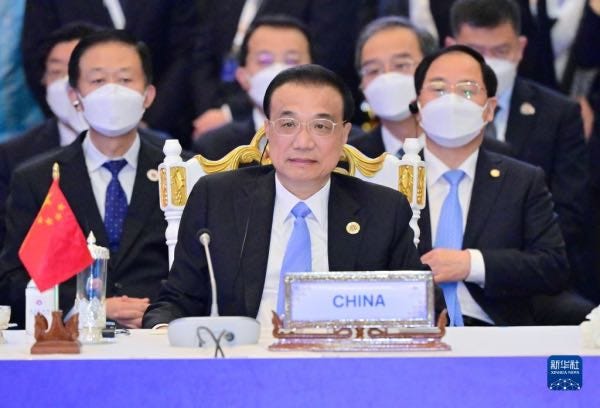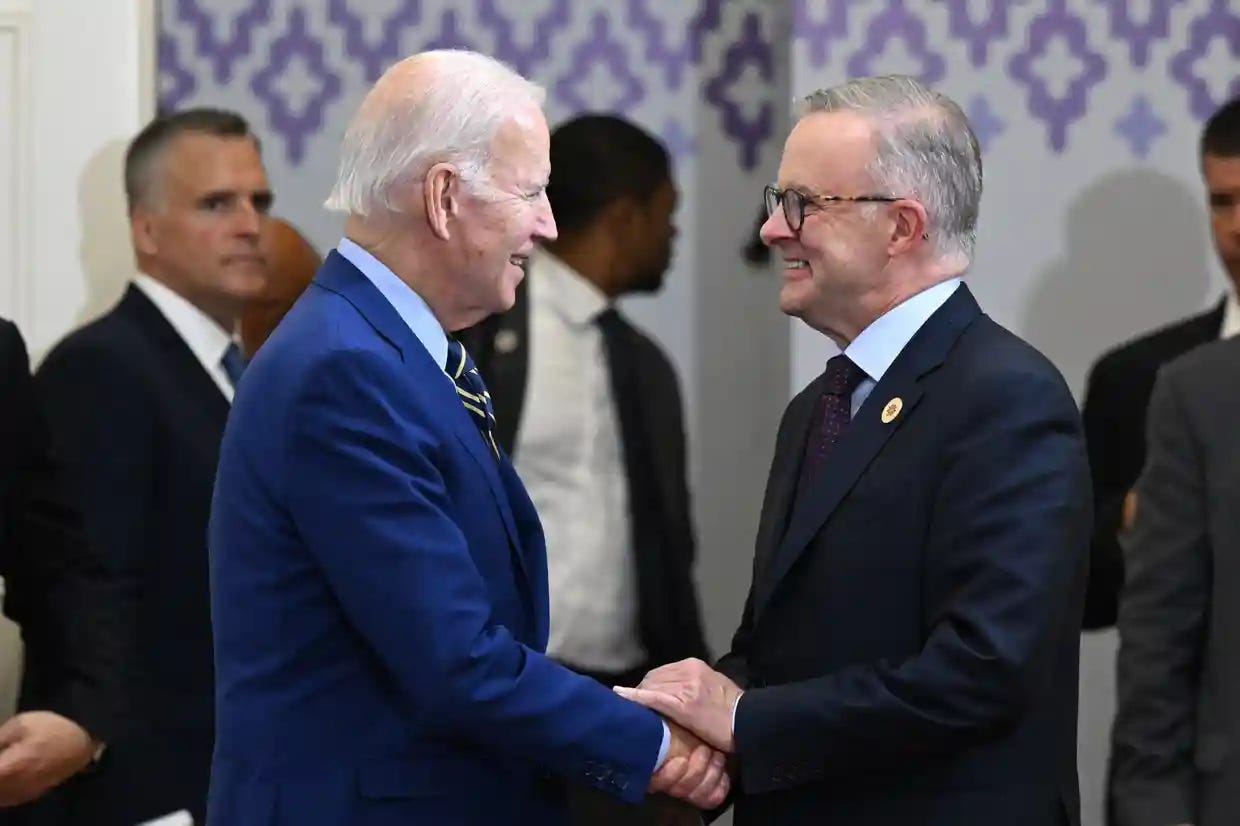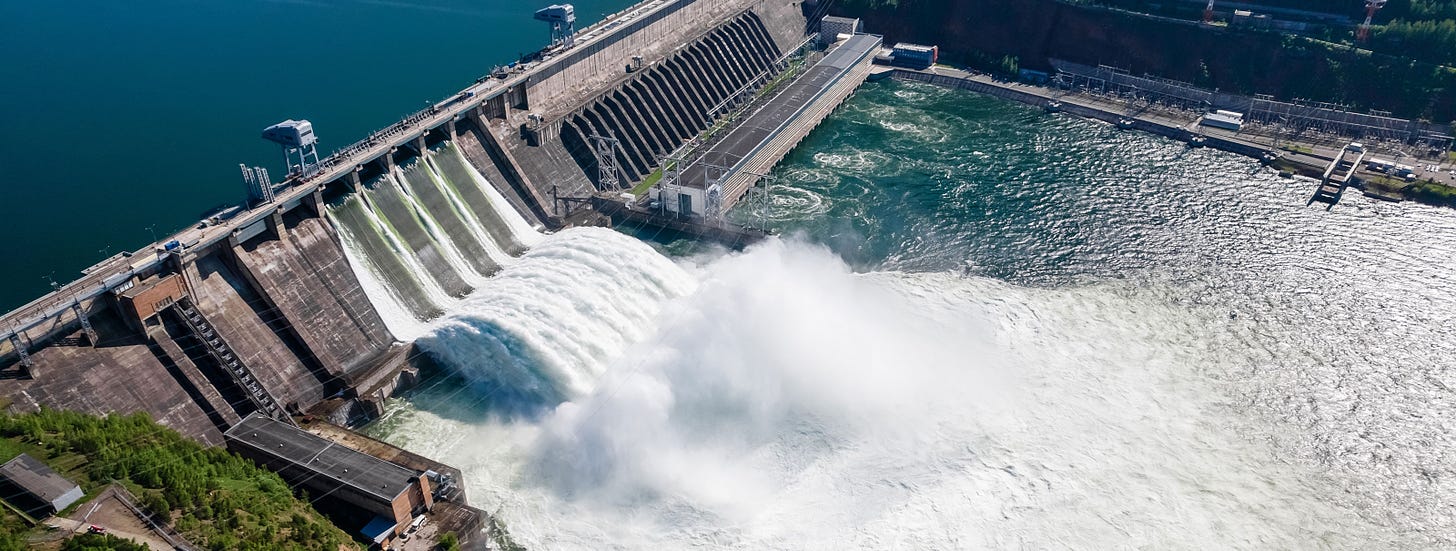Phnom Penh Summit Wrap
China's detailed regional development and security roadmap, US strategy for centrality in ASEAN, COP27 shadowed by fossil-fuel profits and infrastructure boom, and hydropower goes small and micro.
UPDATE: The Long Mekong Daily was on leave for a day following the closing of the ASEAN and EAS summits in Phnom Penh. Apart from the traffic congestion there were over a hundred documents signed by the summit parties. However, China’s approach, outlined by Premier Li Keqiang, to regional development and security tells us much more than the photo blitz of US president Biden and the US strategy to claim centrality in ASEAN. Biden and Australian PM Albanese had a warm extra-regional power meeting about AUKUS and their strategy is to pressure ASEAN, and especially Indonesia, to take sides. Meanwhile, COP27 has been dealt a near lethal blow by the fallout from the Ukraine crisis and the fossil fuel infrastructure surge and windfall profits of US energy giants. Hydropower is being promoted as the renewable energy of choice by the International Renewable Energy Agency (IRENA), and the Mekong has yet to reach its potential for small-scale and micro projects.
Premier Li Keqiang outlines development and security roadmap
It is my real pleasure to gather with you in the beautiful and vibrant city of Phnom Penh for the 25th China-ASEAN Summit. I wish to thank Prime Minister Hun Sen and the government of the Kingdom of Cambodia for the thoughtful preparations and meticulous arrangements made for the summit.
Since the inception of a dialogue relationship in the early 1990s, China and ASEAN have forged ahead together and been a part of each other’s success stories. With mutually beneficial cooperation advancing on all fronts and yielding fruitful outcomes, our two sides have set a fine example of win-win cooperation and common development in the region. In November last year, we held a special summit to commemorate the 30th anniversary of China-ASEAN dialogue relations and formally inaugurated a comprehensive strategic partnership. At that summit, President Xi Jinping proposed jointly building a peaceful, safe and secure, prosperous, beautiful and amicable home. China-ASEAN relations have since come to a new historical starting point. A new and promising chapter of China-ASEAN friendship and cooperation has been opened. Read the entire speech here.
Extra-Regionals seek centrality in ASEAN
Australia’s prime minister met Biden on the sidelines of the East Asia Summit on Sunday in Phnom Penh. That catch-up followed Albanese speaking on Saturday night with the Chinese premier Li Keqiang – which is the first leader-level contact between Australia and China in three years.
Biden’s meeting with the Chinese president in Bali will be the first time the two leaders have met face-to-face since his election to the White House. Biden has reportedly said Monday’s meeting with Xi, which comes amid tensions over Taiwan and a host of other issues, will establish “what the red lines are”.
During their catch up on Sunday, Albanese and Biden canvassed progress on the AUKUS joint agreement with the United Kingdom on nuclear submarines – which remains a deeply contentious issue in the Asean region given the escalating tensions – and Albanese also invited Biden to address federal parliament next year when the president visits Australia for a meeting of the Quad.
With the United Nations-led climate talks also under way in Egypt during the international summit season, Albanese told reporters the two leaders talked about climate action, “and the link between it and economic growth and job creation”.
The substantial catch-up followed Albanese on Sunday addressing both the Asean global dialogue and the East Asia Summit. Albanese used his remarks to address the challenging geo-strategic environment.
The Albanese government is currently attempting to execute a complex diplomatic rapprochement with China that began shortly after Labor won the May election – at the same time as spearheading a diplomatic offensive in the region to repel China’s soft power offensive in the Pacific.
Albanese’s ice-breaking small talk with the Chinese premier at the Asean summit’s gala dinner in Phnom Penh on Saturday night could be a precursor conversation leading to a more substantial meeting with the Chinese president, Xi Jinping, at the G20.
During their chat spanning a few minutes, Li reminded the prime minister he had sent a note congratulating him after Labor’s election victory. Albanese later told reporters he was glad the exchange had happened, but he was coy about the prospects of meeting Xi at the G20.
Albanese addressed regional concerns about the Aukus pact during his contributions to the summits on Sunday. He underlined Australia’s commitment to advancing the nuclear-powered submarine agreement while stressing that Australia remained committed to the principles of the global nuclear non-proliferation regime. Full article here.
Ukraine War Is Driving “a Gold Rush to New Fossil Fuel Infrastructure”
Washington’s vaunted “rules-based international order” has undergone a stress test following Russia’s invasion of Ukraine and here’s the news so far: it hasn’t held up well. In fact, the disparate reactions to Vladimir Putin’s war have only highlighted stark global divisions, which reflect the unequal distribution of wealth and power. Such divisions have made it even harder for a multitude of sovereign states to find the minimal common ground needed to tackle the biggest global problems, especially climate change.
After Russia invaded, the United States and its allies rushed to punish it with a barrage of economic sanctions. They also sought to mobilize a global outcry by charging Putin with trashing what President Biden’s top foreign policy officials like to call the rules-based international order. Their effort has, at best, had minimal success. Yes, there was that lopsided vote against Russia in the United Nations General Assembly, the March 2nd resolution on the invasion sponsored by 90 countries. One hundred and forty-one nations voted for it and only five against, while 35 abstained. Beyond that, in the “global south” at least, the response to Moscow’s assault has been tepid at best. None of the key countries there — Brazil, India, Indonesia, and South Africa, to mention four — even issued official statements castigating Russia. Some, including India and South Africa, along with 16 other African countries (and don’t forget China though it may not count as part of the global south), simply abstained from that U.N. resolution. And while Brazil, like Indonesia, voted yes, it also condemned “indiscriminate sanctions” against Russia.
None of those countries joined the United States and most of the rest of NATO in imposing sanctions on Russia, not even Turkey, a member of that alliance. In fact, Turkey, which last year imported 60 billion cubic meters of natural gas from Russia, has only further increased energy cooperation with Moscow, including raising its purchases of Russian oil to 200,000 barrels per day — more than twice what it bought in 2021. India, too, ramped up oil purchases from Russia, taking advantage of discounted prices from a Moscow squeezed by U.S. and NATO sanctions. Keep in mind that, before the war, Russia had accounted for just 1% of Indian oil imports. By early October, that number had reached 21%. Worse yet, India’s purchases of Russian coal — which emits far more carbon dioxide into the air than oil and natural gas — may increase to 40 million tons by 2035, five times the current amount. Read the entire article here.
Small-scale micro-hydropower projects can make a big difference to communities in remote locations.
Hydropower is energy derived from flowing water. More than 2,000 years ago, the ancient Greeks used waterpower to run wheels for grinding grain; today it is among the most cost-effective means of generating electricity and is often the preferred method where available. In Norway, for example, 99% of electricity comes from hydropower. The world’s largest hydropower plant is the 22.5 gigawatt Three Gorges Dam in China. It produces 80 to 100 terawatt-hours per year, enough to supply between 70 million and 80 million households.
The basic principle of hydropower is using water to drive turbines. Hydropower plants consist of two basic configurations: with dams and reservoirs, or without. Hydropower dams with a large reservoir can store water over short or long periods to meet peak demand. The facilities can also be divided into smaller dams for different purposes, such as night or day use, seasonal storage, or pumped-storage reversible plants, for both pumping and electricity generation. Hydropower without dams and reservoirs means producing at a smaller scale, typically from a facility designed to operate in a river without interfering in its flow. For this reason, many consider small-scale hydro a more environmentally-friendly option.
Hydropower Data
Hydropower without dams and reservoirs means producing at a smaller scale, typically from a facility designed to operate in a river without interfering in its flow. For this reason, many consider small-scale hydro a more environmentally-friendly option. Get the data here.







